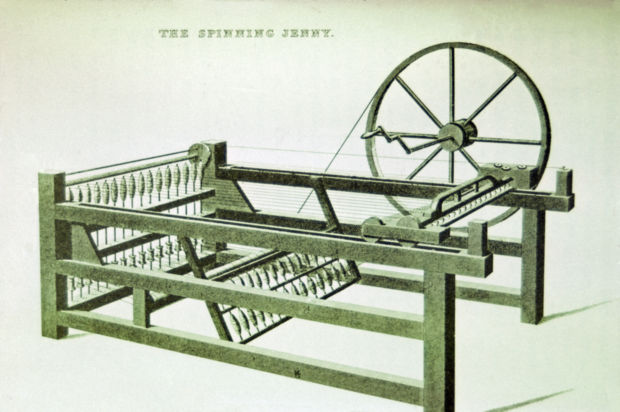Plantation Economy
Reading Level: Elementary School

Aerial image showing Monticello Mountain and some of the areas that would have been farmed by Jefferson’s slaves.
Monticello was a large, 5,000-acre plantation. A plantation tried to grow or make everything it needed. That meant that most food was grown at Monticello. And many goods such as cloth, shoes, bricks, and nails were made at Monticello, too.
Plantations needed many workers. Monticello had some free white craftsmen and workers. But slaves did most of the work. In 1790, Jefferson owned 118 slaves. Overseers managed these enslaved workers.

Leaves of tobacco plants growing at Monticello in 2002. Tobacco was Monticello’s main cash crop until the 1790s.
Cash Crops
Plantations needed to grow a “cash crop.” A cash crop is grown and sold to make money. The plantation owners wanted money to buy sugar and coffee. They wanted money to buy fine goods such as china and cloth from other countries. These things were not grown or made on the plantation.
Tobacco was Monticello’s first cash crop. Many slaves were needed to grow and harvest tobacco. They planted, weeded, topped, and cut the tobacco. Then they hung the leaves in a barn. When the leaves were cured, they were packed into barrels called hogsheads. The hogsheads were rolled to the Rivanna River. Boats took the barrels to Richmond.
By 1794, Thomas Jefferson had decided to grow wheat as a cash crop. All the slaves except for the house slaves (who were busy with their daily chores) harvested the wheat. They worked from sunup to sundown, six days a week. In 1796 Jefferson boasted of a fine harvest of 546 stacks of wheat.

Display approximating the ration of food (cornmeal, fish, and pork) given to each adult slave per week.
Food for All
Food was also grown on the plantation to feed the people who lived there. Jefferson had a “kitchen” garden. Over the years, the garden produced over 300 types of vegetables. Monticello also had fruit orchards and “berry squares.”
Many enslaved workers tended the gardens and orchards. In the spring, slaves plowed the gardens. They planted the seeds. They trimmed the 300 trees in the orchards. In the summer, they weeded and watered. They picked the ripe vegetables and fruits. Jefferson especially loved peas, tomatoes and salads. In late summer and fall, slaves pickled and preserved the vegetables and fruits. These would feed Jefferson’s family during the winter months.
Slaves were not given fruits or vegetables from Jefferson’s gardens. During their “own time,” they tended their own small gardens. They grew cabbage, squash, and melons. They stored them in crocks and in root cellars. They also sold vegetables to Jefferson for his own family.
Hogs and cattle were raised at Monticello. Pork and beef helped feed the families and workers. Enslaved workers tended the hogs and cattle. They cured and salted the meat so it would keep over the winter. Chickens were also raised for meat and for eggs. Most enslaved families had a chicken yard.

Illustration of a “Spinning Jenny” used for spinning cotton or wool into cloth.
Plantation Industry
Skilled craftsmen made goods for the plantation. Many were slaves. They made tools, plows and carriages. They built barns and sheds. In the textile shop, enslaved women and girls spun thread and wove cloth. It was used to make the slaves’ clothing. Workers in the joinery crafted windows and doors. They made woodwork and furniture for Jefferson’s home. Blacksmiths made horse shoes, hoes and axes.
Some of the industries made money for the plantation. In the nailery, ten to sixteen year old slave boys made from 8,000 to 10,000 nails a day. Nails not used on the plantation were sold. Neighborhood farmers brought horses to the blacksmith shop for horse shoes.
Overseers
Jefferson was often away from Monticello. He hired free men as overseers to manage the enslaved workers. Edmund Bacon was overseer of Monticello from 1806 to 1822. Great George was Jefferson’s trusted black overseer for three years. He was the only Monticello slave to be paid a wage. Some of the overseers, like William Page, were cruel and feared by the slaves.

Jefferson’s grandson ran this ad announcing the public sale of Monticello and other personal property including “130 valuable negroes.”
Debt
Thomas Jefferson was always looking for ways to make money on his plantation. But he was away from home too often. Many of his ideas failed. He also enjoyed spending money. And many guests stayed at Monticello. Jefferson often owed people money. In 1824, a visitor to Monticello said that Jefferson’s home was “rather old and going to decay.” In 1826, Jefferson died. His slaves and the furnishing of his home were sold. The money was used to help pay off what he owed. Five years later, Jefferson’s beloved Monticello was sold, too.

